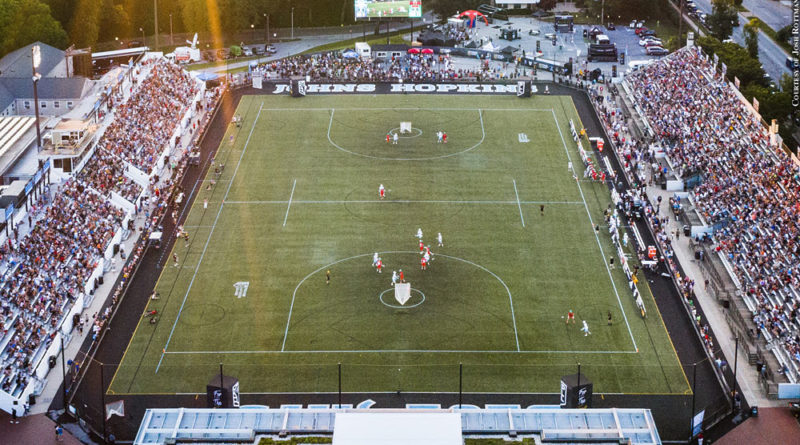By Gus Martin
The upstart Premiere Lacrosse League had its first big-time fan showing last weekend when reportedly 16,701 people were in attendance at Homewood Field of Johns Hopkins University during the course of three games.
June 22 marked the most important night for the league thus far, however, when a sellout crowd of about 10,000 fans packed the stadium to watch a night game between the Whipsnakes LC and Atlas LC. The teams are filled with former Maryland and Hopkins players, respectively.
Hopkins lacrosse icon, Atlas midfielder and PLL co-founder Paul Rabil views the weekend as an example of what the league could be if it continues on its current growth trajectory.
“It was amazing. … We set out every week to exceed all of our metrics and assumptions,” Rabil, 33, said on PLL Weekly June 25. “More importantly, though, we’re looking to constantly iterate and learn, and we’re learning every week about what works.”
The PLL is now four weeks through its 14-week season, with six teams competing each week as part of a barnstorming tour. Rabil says he’s happy with the league’s reception from fans as well as its players’ performance on the field. Professional lacrosse leagues haven’t garnered much national attention in the past, and Rabil knows it will take more than just high-level play and talented athletes to keep fans tuned in going forward.
“The teams are highly competitive and I have never seen games move as quickly and be as spirited and as physical as the ones we’re seeing now,” Rabil said. “The three categories that I’d say are most important [to the league’s growth] are you have the best players in the world, you have a mass-distribution deal, which we do with NBC, and then you play at premium venues where the atmosphere is exciting.”
Rabil emphasizes promoting the league’s players and teams on social media as a major factor in the success of the PLL’s Homewood Field weekend and throughout the league’s first season. He wants players to speak their minds and build their brand — and consequently the league’s brand — and interact with fans as much as possible.
He compared the strategy in some ways to the NBA and how fans and the media talk about off-the-court developments almost as much if not more so than the play on the court.
“What we do tactically is help them create media so we can support their social accounts,” Rabil said. “… That creates this whole loop of where we’re seeing elevated attention and interaction with our league through our players, so that is definitely a goal of ours.”
Rabil does not, however, want the league’s focus on promotion to detract from its on-field product. Instead of the PLL being a “social media-driven league” or entirely focused on publicity, he views competition and entertainment as tools that work together to help quickly grow the league’s popularity.
“Last-second shots and come-from-behind wins are as ephemeral as your ability to discern who it was. Once you know who that person was, then that come-from-behind win and last-second shot means more,” Rabil said. “One of the objective things I say pretty often and remind people is, ‘Look, we can’t, nor do we expect to have the Boston Red Sox vs. the New York Yankees right now. We don’t have over 100 years of competition.'”
The league did make an effort to instill some rivalry into its games by putting some players from the same colleges on the same team so they could use the school’s rivalries, like John Hopkins vs. Maryland, to help bolster fan interest and player performance even more so, but this could all change soon.
The PLL doesn’t have free agents yet because each player is locked into a multi-year deal, but the league’s “trade window” opened last week and closes in the third week of July, so Rabil says fans can expect more roster moves in the coming weeks.
“We have an existing waiver wire as well,” Rabil said. “… That all is a huge part of maintaining the core principles of a team-sports league [by] enabling your coaches and their organization to best position their talent to make a playoff push. The only difference [for the PLL] is we don’t have individual team owners that are using or leveraging economics to acquire a free agent.”
Rabil and the rest of the league hope to see more nights like June 22 along its touring schedule, but he is not blind to the fact that Baltimore is a hotbed for lacrosse fandom and there is still work to be done to stretch the league nation-wide.
For now, the PLL will continue combining high-level lacrosse with entertainment appeal on the field and in the media.
“Teams are continuing to build culture and fans are deciding who their favorite clubs are based on their favorite players, their favorite coaches or the culture of winning and losing that that team is developing,” Rabil said. “We not only encourage them to be themselves but support their personalities. That’s the essence of pro sports.”
To hear more from Rabil, listen to the full show here.
Photo Credit: Josh Rottman

